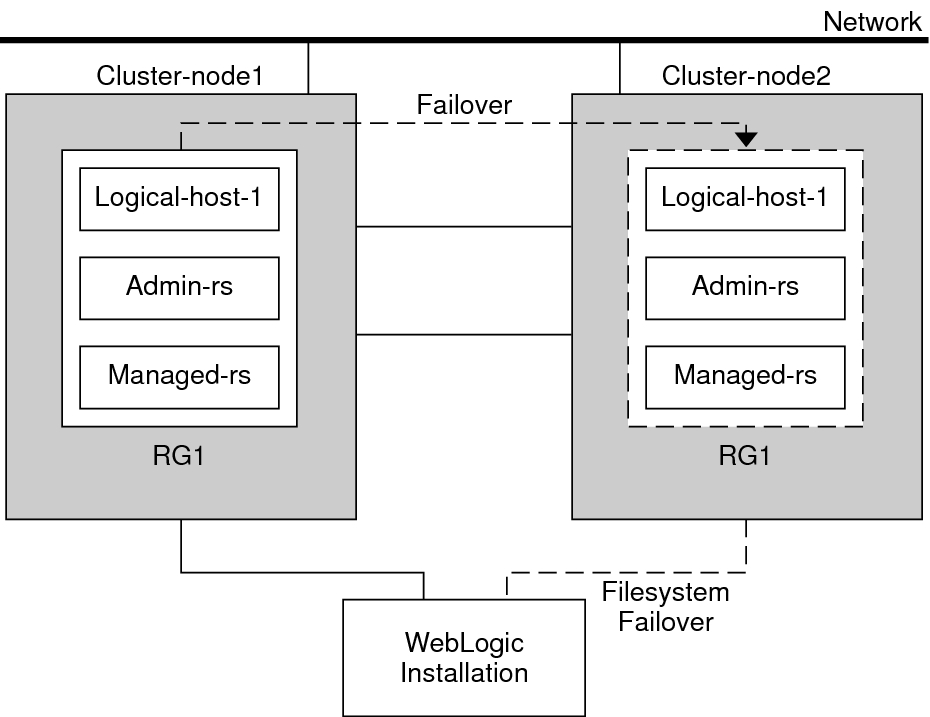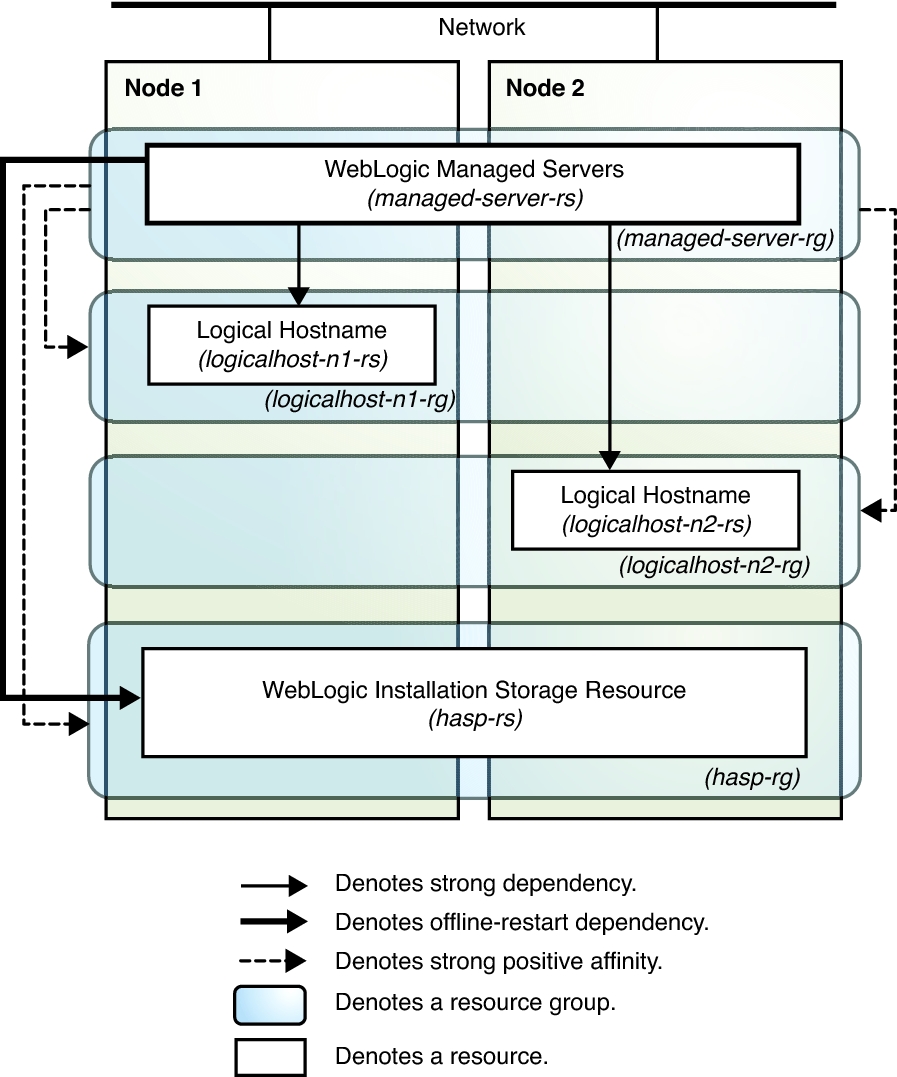Planning the HA for WebLogic Server Installation and Configuration
This section contains the information you need to plan your HA for WebLogic Server installation and configuration.
Configuration Restrictions
 | Caution - Your data service configuration might not be supported if you do not observe these restrictions. |
This section provides a list of software and hardware configuration restrictions that apply to the HA for WebLogic Server. Use the restrictions in this section to plan the installation and configuration of HA for WebLogic Server.
For restrictions that apply to all data services, see the Oracle Solaris Cluster 4.4 Release Notes.
-
HA for WebLogic Server provides high availability to stand-alone WebLogic Server instances (instances not using WebLogic Server clustering).
-
For a failover file system, all WebLogic Server instances using that file system must be configured in a single resource group.
-
For a multi-master configuration, the WebLogic software can be installed in the failover or global file system, or in the local file system on all Oracle Solaris Cluster nodes.
-
If you want to configure different instances in different resource groups, the WebLogic Server installation must be on a global file system.
-
If the WebLogic Server cluster directory and other configuration files are installed on a global file system and you want to configure WebLogic Server in a zone cluster, use the SUNW.HAStoragePlus resource type to make a cluster file system available to zone cluster nodes. For information on the HAStoragePlus configuration for a zone cluster, see Installing and Configuring an Oracle Solaris Cluster 4.4 Environment.
Configuration Requirements
 | Caution - Your data service configuration might not be supported if you do not adhere to these requirements. |
Use the requirements in this section to plan the installation and configuration of HA for WebLogic Server. These requirements apply to HA for WebLogic Server only. You must meet these requirements before you proceed with your HA for WebLogic Server installation and configuration.
For requirements that apply to all data services, see Configuration Guidelines for Oracle Solaris Cluster Data Services in Planning and Administering Data Services for Oracle Solaris Cluster 4.4.
-
If the WebLogic Server home directory and other configuration files are installed on a failover file system using HAStoragePlus, then all WebLogic Server resources using that file system should be configured in the same resource group.
-
If the WebLogic Server depends on any database, such as Oracle or Sybase, the administrator must ensure that the database is highly available before configuring and starting the WebLogic Server under HA for WebLogic Server.
-
In WebLogic Server, the Managed Servers can be configured to start independently in "Managed Server Independence mode". For the HA for WebLogic Server, the administrator must configure all Managed Servers to be able to start independently.
To configure the Managed Server in independent mode, see the relevant WebLogic Server documentation for the version you are using. For example, for WebLogic Server 12c, the documentation is located at http://docs.oracle.com/middleware/1212/wls/index.html.
-
You can configure separate scripts to start the WebLogic Server Managed Servers. If separate scripts are configured, the Administration Server URL and the Managed Server name must be set in the START script. The scripts should be able to start each WebLogic Server instance without arguments.
-
If you intend to use a single START script to start several Managed Servers, the Administration URL must be specified in the START script and only the Managed Server name should be taken as the argument to the script. For example, if the script used to start the Managed Server is startManagedWeblogic.sh, then the Managed Server petstore_server should be able to start as follows:
node1>cd /global/wls/user_projects/petstore node1>./startManagedWeblogic.sh petstore_server
-
The WebLogic Server START script needs a user name and password. You configure the $DOMAIN_DIR/boot.properties file to store the user name and password which are encrypted after the first startup of the WebLogic Server. The $DOMAIN_DIR/boot.properties file also enables a smooth shutdown when used with a resource for which the extension property smooth_shutdown is set to TRUE.
Note - Starting with WebLogic Server version 10.3, the boot.properties file must reside in both the $DOMAIN_DIR and $DOMAIN_DIR/servers/server-name/security directories to bypass the need to prompt for user credentials when starting and stopping instances of WebLogic Server. If the $DOMAIN_DIR/servers/server-name/security directory does not exist or does not include a boot.properties file, create the directory and copy the boot.properties file from the $DOMAIN_DIR. For more information about the boot.properties file for WebLogic Server version 12c, see http://docs.oracle.com/middleware/1212/wls/START/overview.htm#START112. -
All required environment variables must be set in the WebLogic Server environment file before you start the server. For details about the WebLogic Server environment file, see the relevant WebLogic Server documentation for the version you are using. For example, for WebLogic Server 12c, the documentation is located at http://docs.oracle.com/middleware/1212/wls/index.html. To set the path to the WebLogic Server environment file, use the Environment_File property described in HA for WebLogic Server Extension Properties.
-
To enable the discovery of running Managed Servers after a failover and restart of an Administration Server, ensure that the Administration server START script does not include -Dweblogic.management.discover+=false. This setting disables the Administration Server from discovering its running Managed Servers. For details, see the relevant WebLogic Server documentation for the version you are using. For example, for WebLogic Server 12c, the documentation is located at http://docs.oracle.com/middleware/1212/wls/index.html.
-
Ensure that the host names used in the Server_url and monitor_uri_list are resolvable. If you use Fully Qualified Domain Names (FQDNs), then DNS must be enabled and /etc/nsswitch.conf must have the correct entries to resolve the host names using DNS.
Note - To avoid any failures due to delays in name-service lookup, the host name used in the Server_url property should be added to the /etc/hosts file. Configure name-service mapping in the /etc/nsswitch.conf file on the servers to first check the local files before trying to access other name services.
Standard Data Service Configurations
Use the standard configurations in this section to plan the installation and configuration of HA for WebLogic Server. HA for WebLogic Server supports the standard configurations in this section.
In addition to the standard configurations provided in this section, the following WebLogic Server configurations are possible:
-
Separate START script for each WebLogic Server (Administration and Managed)
-
Single START script for all Managed Servers which takes the Managed Server name as the input
-
Setting the user name and password in the $DOMAIN_DIR/boot.properties file
This configuration enables a smooth shutdown by HA for WebLogic Server 8.1 or later versions .
Note - Starting with WebLogic Server version 10.3, the boot.properties file must reside in both the $DOMAIN_DIR and $DOMAIN_DIR/servers/server-name/security directories to bypass the need to prompt for user credentials when starting and stopping instances of WebLogic Server. If the $DOMAIN_DIR/servers/server-name/security directory does not exist or does not include a boot.properties file, create the directory and copy the boot.properties file from the $DOMAIN_DIR.
Note - The WebLogic Server can be configured either as a failover data service, multi-instance data service, or multi-master data service.
HA for WebLogic Server might support additional configurations. Contact your Oracle service provider for information about additional configurations.
WebLogic Server Configured as a Failover Resource
Simple Configuration
This simple configuration for the HA for WebLogic Server uses two resource groups configured as follows.
-
RG1 containing logical-host-1 and WLS-Admin-Server-resource
-
RG2 containing logical-host-2 and WLS-Managed-Server-resource
RG1 and RG2 are failover resource groups.
This configuration is possible only if the WebLogic Server is installed on a cluster file system. See HA for WebLogic Server Simple Configuration for an illustration of this configuration.
Figure 1 HA for WebLogic Server Simple Configuration

Configuration 1
In this configuration, RG1, RG2, RG3, and RG4 are failover resource groups configured as follows.
-
RG1 containing logical-host-1 and WLS-Admin-resource
-
RG2 containing logical-host-2 and WLS-Managed-Server-resource2
-
RG3 containing logical-host-3 and WLS-Managed-Server-resource3
-
RG4 containing logical-host-4 and WLS-Managed-Server-resource4
This configuration is possible only if the WebLogic Server is installed on a global file system.
Configuration 2
In this configuration, RG1, RG2, and RG3 are failover resource groups configured as follows.
-
RG1 containing logical-host-1, WLS-Admin-resource, and WLS-Managed-Server-resource1
-
RG2 containing logical-host-2, WLS-Managed-Server-resource2, WLS-Managed-Server-resource3, and WLS-Managed-Server-resource4
-
RG3 containing logical-host-3, WLS-Managed-Server-resource5, WLS-Managed-Server-resource6, WLS-Managed-Server-resource7
This configuration is possible only if the WebLogic Server is installed on a global file system.
Configuration 3
If the WebLogic Server is installed on a failover file system by using HAStoragePlus, all the WebLogic Server instances must be configured in the same failover resource group that has a dependency on the failover file system.
RG1 contains logical-host-resource resources and all Administration and Managed Server resources.
For information about how to register a resource with dependency on an HAStoragePlus resource, see Enabling Highly Available Local File Systems in Planning and Administering Data Services for Oracle Solaris Cluster 4.4.
See HA for WebLogic Server File System Failover Configuration for an illustration of this configuration.
Figure 2 HA for WebLogic Server File System Failover Configuration

WebLogic Servers Configured as a Multi-Master Resource
This example illustrates a multi-master configuration for HA for WebLogic Server (configured as a cluster).
In multi-master data service configuration, the WebLogic Server resource is used in a scalable resource group. The WebLogic Server Managed Server resource is online on multiple nodes at the same time.
In this configuration shown in WebLogic Server Configured as a Multi-Master Resource, a single resource group managed-server-rg includes the Managed Server resources running on Node 1 and Node 2. Each Managed Server resource depends on a logical host resource and group that contains only one node.
Figure 3 WebLogic Server Configured as a Multi-Master Resource

WebLogic Servers Configured as Multi-Instance
Multi-instance is an application configuration topology where multiple instances of the same application provide an aggregation of services. This topology can be achieved independently of using a data service because you can manually start and stop the instances on the cluster nodes. When HA of such instances is required, you can enable a data service for the instances by creating multiple single-node resource groups or a few multi-master resource groups.
The diagram in WebLogic Server Configured as a Multi-Instance Application With Single-Node Resource Groups illustrates a multi-instance configuration using single-node resource groups. A single-node resource group is created for each of the Managed Server resources. The resource groups are represented by managed-server-n1–rg and managed-server-n2–rg in the diagram. Each resource group has a strong positive affinity on a storage resource group hasp–rg and a logical host resource group whose primary node is the node containing the Managed Server resource group.
Figure 4 WebLogic Server Configured as a Multi-Instance Application With Single-Node Resource Groups
